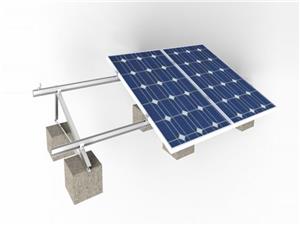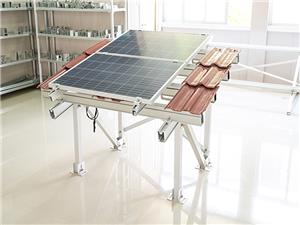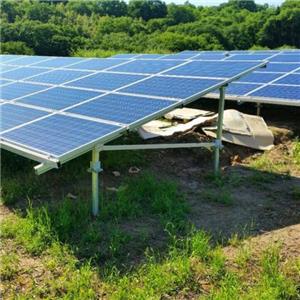knowledge of solar mounting system
Today,introduce the difference among different solar mountings,such as ground solar mounting, and roof solar mounting.
Fixed Racks
Fixed solar mounts are installed flush to a roof or other area at a set tilt, so they are stationary and do not require a tracking system. These are typically used in residential and small-commercial applications with non-concentrating systems.
Though fixed mounts can’t move in conjunction with the sun’s position, they do offer some advantages. First off, they are simple structures and so cost less than other mountings with easy installation and maintenance. Also, wind loading concerns are greatly reduced with fixed panels because they are not as exposed as other mounted types.
However, fixed solar mounts are the least flexible. Because the panel angle can’t be easily changed, the amount of sunlight the system can absorb is limited. Fixed mounts need to be positioned correctly, usually pointing toward the equator, to absorb as much light as possible. Trade-offs exist between the use of tracking systems that can capture more of the sun’s energy per day and fixed-rack systems that may be lower in installation and maintenance costs.
Ground Mounted
As the name implies, ground-mounted solar is placed directly on the ground. The mount consists of a steel or aluminum frame attached to a concrete foundation.
Trade-offs exist between ground and roof-mounted systems. Ground mounts offer flexibility in space and sizing, but can be bulky and require a foundation. Rooftop arrays use the existing structure, which eases design and lowers construction cost.
Ground mounts are easier to access, but need more racking and mounting equipment. However, pitch and orientation is already set on rooftops so ground-mounted systems have more options for incorporating tracking to maximize production. Also, solar panels perform best in cooler temperatures. More air tends to circulate behind the solar panels of a ground-mounted array than those of a rooftop system, so they stay cooler and often outperform rooftop systems. Ground mounts are well-suited for rural, off-grid areas that don’t have heavy snowfall. Their ability to provide significant electrical power makes them great for utility-scale installations.
Roof Mounted
Roof mounts are simply solar panel mounts that can be placed on a roof. Supporting adjustable legs allow adjusting panel orientation vertically for maximum exposure. Solar panels in these systems are held in place by racks or frames attached to roof-based supports.
There are two types of roof mounts. Pole mounts penetrate the roof, attaching directly to it, and may use additional rails for connecting the panel racking or frames. Ballasted-footing mounts are concrete or steel bases that use weight to secure the panel in position. These are often preferable because they do not require drilling holes into the roof, and so allow decommissioning or relocating systems without damage.
Trade-offs exist between roof and ground mounted systems. Ground mounts can be bulky and require a foundation, but rooftop arrays use the existing structure. Roof mounts also can resist strong winds and heavy rain, while harsh elements and snow can be a problem for ground mounts. Ground mounts are easier to access, but need more racking and mounting equipment. Also, pitch and orientation is set on rooftops so ground-mounted systems have more options for incorporating tracking to maximize production. Roof-mounted solar makes use of space that would otherwise go unused. It doesn’t require plots of land, which is particularly relevant with larger commercial and utility-scale projects. Though there are large rooftop solar systems, roof mounts are especially used in residential and small commercial applications.
PV Module Mounting Systems
There are several mounting options for PV panels including roof, pole, and ground mounts. Some PV mounts also include option for tracking.
Roof mounting is the most common, in which panels are mounted onto or into the roof. Roof mounted solar makes use of space that would otherwise go unused. It doesn’t require plots of land, which is particularly relevant with larger commercial and utility scale projects. Tough there are large rooftop solar systems, roof mounts are especially used in residential and small commercial applications. One drawback is that panel orientation is set, but flush rooftop mounts are often more resistant to strong winds and heavy rain.
Pole mounts are often steel mounted and highly adjustable. They are driven directly into the ground or in concrete. Because they are so easy to install, they can be placed in almost any location that will maximize sunlight exposure. Some versions are even adjustable to optimize orientation. However, one downside is quantity limitation because pole mounted systems usually have a safety maximum of six to eight modules. Pole mounted solar is often used to power streetlights or auxiliary equipment to eliminate the expense of a power line connection.
Areas with ample ground space allow laying out large numbers of tied solar panels in one place. However, ground mounts can be expensive because they require steel supports, concrete structures and galvanized footings. Still, ground mounts have a variety of tracking options to maximize sunlight exposure and energy production. This type is mounting is especially suitable for utility-scale and rural installations.




